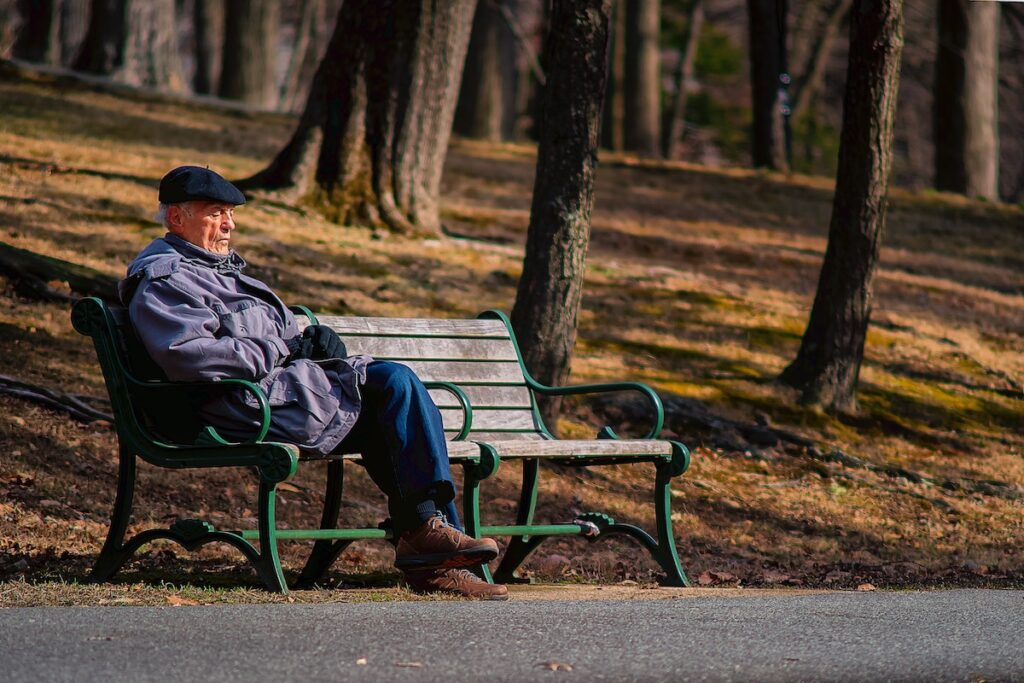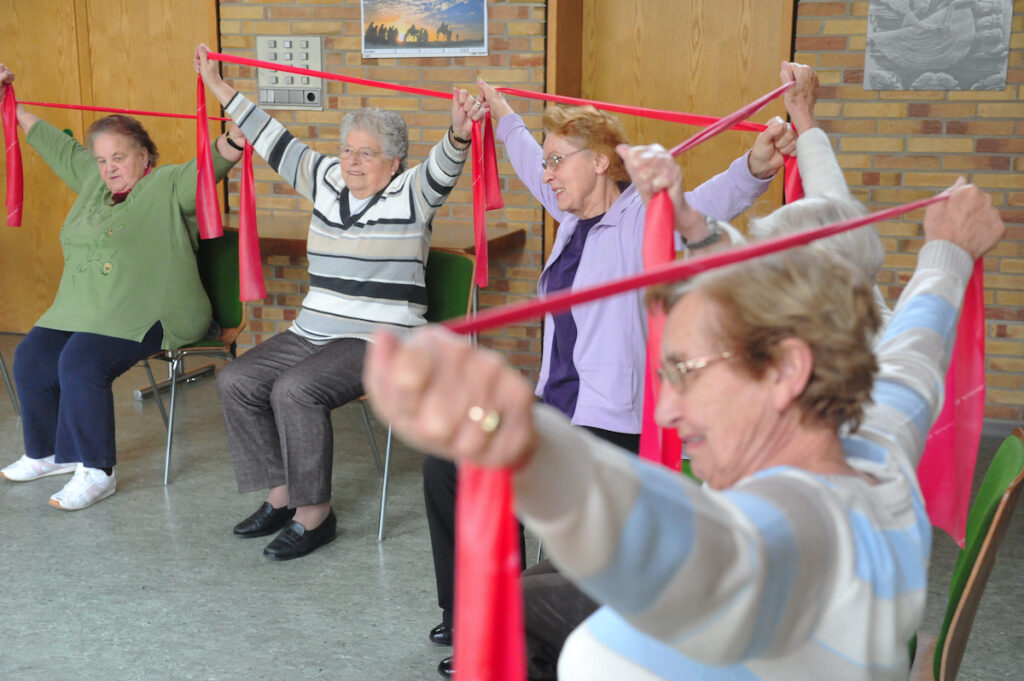
In the UK, around 4 million older adults (aged 65+) are living alone (Office for National Statistics, 2020). Living alone can be linked to greater levels of social isolation and feelings of loneliness, but by no means do people living on their own in general necessarily feel socially isolated. There is a great deal of information about loneliness in older adults from Age UK out there. The charity has created a so called ‘loneliness map’ based on the English Longitudinal Study of Ageing (or ELSA for short), where you can check for areas of particularly high levels of risk of loneliness in older adults. These maps are based on Census data on marital status, self-reported health status, age, and household size.
The pandemic has put a stark spotlight on loneliness and social isolation, which have already affected a large proportion of the population, including older adults, before the pandemic. Yet, the pandemic has exacerbated or newly caused these feelings for many. A recent study from the Netherlands for example has shown how loneliness has increased in older adults, whilst their mental health has remained relatively stable (van Tilburg et al., 2021). Interestingly, in a UK survey on COVID-19 psychological well-being for the adult population, younger age groups were found at higher risk of loneliness than older adults (Groarke et al., 2020).
Loneliness in older adults can be particularly debilitating though. Advanced age can often come with increased health problems and comorbidities. Now imagining an older person being isolated at home and lonely, possibly not going outside much as a result of having little to no social contacts, can lead to a lack of physical engagement. Instead of going outside to a café or sports group (yes, some older people can also run marathons!) for example, a very lonely and socially isolated person may just stay at home, not going out. At some point they may even lack the enthusiasm to go for a walk or similar things that we do as part of our every day life. This can then easily lead to frailty – if we don’t stay active, because we don’t feel we have a reason to. Whilst there doesn’t seem to be a statistic for the proportion of older people reporting frailty, using Hospital Episode Statistics data Soong et al. (2015) reported an increase in frailty reports in older adults admitted to hospital in England.
So, for this blog, I am looking at a recent study by Davies and colleagues (2021) published in The Lancet Healthy Longevity, which utilised data from the English Longitudinal Study of Ageing (ELSA) to explore the longitudinal relationship between loneliness, social isolation, and frailty in older adults.

Loneliness and social isolation can negatively affect everyone, while it can have a detrimental impact on older adults. This study by Davies and colleagues (2021) aims to further understand the longitudinal relationship between loneliness, social isolation, and frailty in older adults.
Methods
The authors used data from Waves 2 to 8 from the ELSA, which spanned from June 2004 to June 2017. ELSA collects data from middle-aged adults aged 50+ every year or two, including basic socio-demographic data, as well as health care usage and various valid questionnaire measures on frailty, mental well-being, and others. Overall, it provides a strong longitudinal database allowing for different types of investigations.
For this particular study, the authors used data from the UCLA 3-item Loneliness Scale. To measure social isolation, a specific approach was used which allocated 1 point to the following variables: not being married/cohabitating; less than 1 monthly contact with family members (child, other members, friends); no member of an organisation. A total score of 5 could be reached, with higher scores indicating social isolation. To assess frailty, the frailty index was used, which involved taking information from 59 different ELSA variables, including on the functional, psychological, and social deficits of an individual.
The frailty index was thus a continuous variable, which was employed in linear mixed models as the outcome variable. Social isolation and loneliness were used as key independent variables to assess how both of these were associated with frailty over the time period of investigation, between 2004 and 2017. Ethnicity, gender, education, age, marital status, wealth, and smoking status were also included as covariables.
Results
In total, the study included data from 9,171 participants (majority female), with the mean age of participants at baseline (Wave 2) being 66.3 (+/-10.2). In their Cox proportional hazard ratio models, the authors showed that relative to low social isolation, medium or high social isolation were significantly riskier in developing frailty. The same was true when medium or high levels of loneliness were compared to low levels of loneliness, showing that both social isolation and loneliness were associated with higher levels of risk to developing frailty.
The authors also looked at frailty data longitudinally over the 14-year period, and showed that with age, frailty rates increased. This association of increased age – increased frailty was predicted by both loneliness and social isolation.

The findings suggest that older adults who reported medium or high social isolation and loneliness are at higher risk of developing frailty.
Conclusions
The authors highlight the important role that loneliness and social isolation can play in developing frailty in old age. This is particularly important at a time when COVID-19 restrictions have been in place for a prolonged period of time over the past 18 months in the UK/ in the four nations, and across the globe. The authors rightly refer to the negative impacts that being restricted to one’s own home, or being told to shield, can have on feelings of loneliness and social isolation, which may cause difficulties in terms of frailty for older adults in the long-term. Therefore, it would be interesting for the authors to revisit the ELSA once a future wave is added to explore the potential impact of public health restrictions on frailty, with the ELSA offering a unique opportunity of collecting these longitudinal data.

The authors highlight the importance of understanding the role loneliness and social isolation have in association with frailty in old age, especially within the context of Covid-19 pandemic and the imposed restrictions.
Strengths and limitations
Overall, the study benefits from using longitudinal, routinely collected data from the ELSA, spanning a 14-year time period. This, as well as the large sample size, strengthens the representativeness and validity of the findings, with the authors using suitable longitudinal statistical methods to explore the topic of social isolation, loneliness, and frailty in older adults.
A slight oddity I found when reading the paper is that the authors continuously refer to older people (which are classed as 65+ years of age in high-income countries, as is the case here). However, the ELSA collects data from middle-aged and older adults, so people aged 50+, and the authors do state that they include data from people aged 50+. Social isolation and loneliness can indeed be present in people of any age, so it makes sense to also look at people below the age of 65. Nevertheless, for the purpose of this study, the authors should be clearer with their terminology, and be more precise in the title, abstract, and the manuscript throughout that they are actually investigating middle-aged to older adults.

Overall, the robust design of this longitudinal study strengthens the representativeness and validity of the findings, however, appropriate and clear definitions of the ‘older age’ population are needed.
Implications for practice
Social care is vital. Social care services, such as support groups or social activities in the community, can combat feelings of loneliness and social isolation in older adults. One example is Community Connectors, a service run in the North West of England which gradually tackles people’s independence by integrating them, via a volunteer, with social activities in their own community (Giebel et al., 2020). These services are often run by third sector organisations though, and are sometimes unsustainable without any financial support from the Government. Some of these services also require a nominal fee from an attendee, which makes sense if they offer crafts or a sports activity or food, etc.
In light of a lack of social care funding boost in the recent Budget announcement, the social care crisis is far from over and instead only growing. What this research hints at is how important these types of community services can be for older people who may not have family members living close by, or at all. So, an implication for practice, and by that the social care sector, is for these services to be financially supported by the Government, or, for older people to be generously means-tested to receive a social support budget to choose freely what types of activities and groups they wish to engage with on a monthly basis.
One way these findings could influence working practices of mental health practitioners could be for social prescribing link workers, if they are indeed in place across the country, to better refer older adults to community groups. This also means that GPs need to work closely with social prescribing link workers and pick up on issues when they see the older person as part of their routine visits. However, the pandemic has deterred people from attending their GP, and instead many people likely have gotten worse physically and mentally at home. Thus, there is a clear need for better, proactive regular engagement of frontline staff to engage with older adults and just check-up – maybe a 6-monthly phone call is all that is required, to then link up with a link worker or other professional.
It is just not acceptable, and taking a turn for the worse every day, that some of the most vulnerable people in our society, and those that feel left out, are indeed left out by the Government. Social care is not sustainable by relying on the free labour of volunteers and unpaid carers. The time to act was yesterday, but acting today can still help.

Social care services, such as support groups or social activities in the community, can combat feelings of loneliness and social isolation in older adults. GPs and mental health practitioners should consider social prescribing and collaborating with link workers to better understand their social needs.
Statement of interests
None.
Links
Primary paper
Davies, K., Maharani, A., Chandola, T., Todd, C., & Pendleton, N. (2021). The longitudinal relationship between loneliness, social isolation, and frailty in older adults in England: A prospective analysis. The Lancet Healthy Longevity, 2(2), e70–e77.
Other references
Giebel, C., Hassan, S., Harvey, G., Devitt, C., Harper, L., & Simmill-Binning, C. (2020). Enabling middle-aged and older adults accessing community services to reduce social isolation: Community Connectors. Health & Social Care in the Community, hsc.13228.
van Tilburg, T. G., Steinmetz, S., Stolte, E., van der Roest, H., & de Vries, D. H. (2021). Loneliness and Mental Health During the COVID-19 Pandemic: A Study Among Dutch Older Adults. The Journals of Gerontology: Series B, 76(7), e249–e255.
Groarke, J. M., Berry, E., Graham-Wisener, L., McKenna-Plumley, P. E., McGlinchey, E., & Armour, C. (2020). Loneliness in the UK during the COVID-19 pandemic: Cross-sectional results from the COVID-19 Psychological Wellbeing Study. PLOS ONE, 15(9), e0239698.
Soong, J., Poots, A., Scott, S., Donald, K., Woodcock, T., Lovett, D., & Bell, D. (2015). Quantifying the prevalence of frailty in English hospitals. BMJ Open, 5(10), e008456.
Office for National Statistics 2020. People living alone aged 65 years old and over, by specific age group and sex, UK, 1996-2019. London, England.
Photo credits
- Photo by Robert Thiemann on Unsplash
- Photo by Forest Simon on Unsplash
